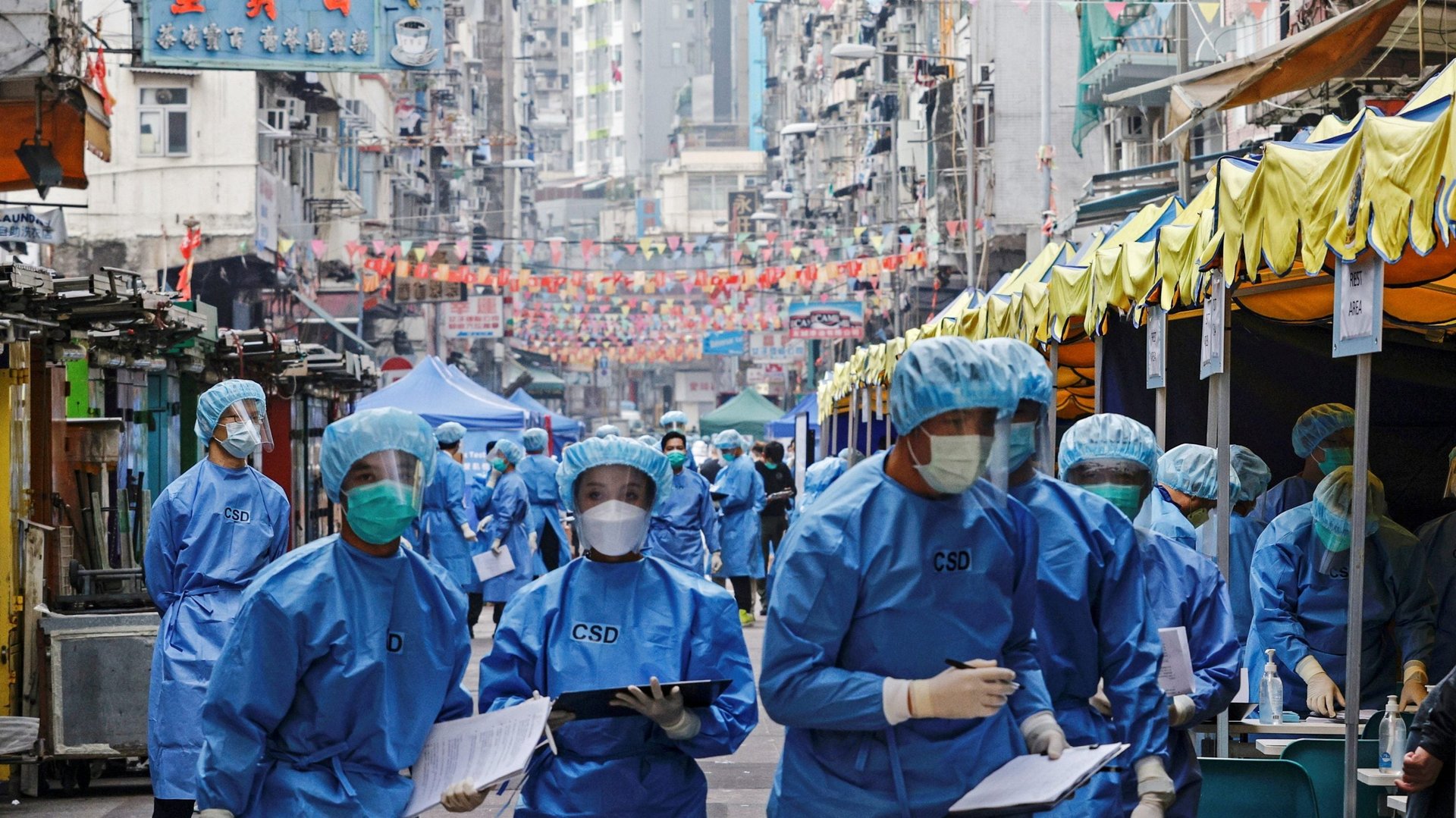Hong Kong’s latest Covid-19 strategy: daily ambush lockdowns
The short video quickly went viral: a single police officer sprinting up a street while rapidly unrolling police tape, with half a dozen somewhat less nimble colleagues following on his heels.


The short video quickly went viral: a single police officer sprinting up a street while rapidly unrolling police tape, with half a dozen somewhat less nimble colleagues following on his heels.
The cops weren’t chasing down protesters or runaway suspects, however. Rather, they were sealing off four apartment blocks in a sudden unannounced lockdown in Hong Kong’s North Point neighborhood, part of the government’s latest efforts to restrict movement and conduct mass compulsory testing to stamp out Covid-19 cases.
Last month, almost a year to the day since Chinese authorities imposed a harsh lockdown on Wuhan amid a spiraling coronavirus outbreak, Hong Kong enforced its first ever pandemic lockdown. Up until that point, Hong Kong had not felt the need to resort to the full-scale restrictive lockdowns of the kind seen in Italy or the UK, instead largely keeping cases under control through a combination of measures like universal masking, social distancing, border restrictions, quarantines, targeted testing, and contact tracing. The measures have been largely successful: the city of 7.4 million has so far recorded just over 10,000 cases and under 200 deaths.
Now, however, the government is throwing its weight behind a new strategy: ambush-style lockdowns at a rate of at least one a day over the next two weeks. The approach involves temporarily sealing off a set of residential blocks for between 12 to 48 hours, with residents ordered to stay within their premises and undergo mandatory coronavirus testing. The lockdown is lifted once everyone has been tested and the results confirmed.
The militant branding of the public health campaign is the government’s own making, with top official Carrie Lam having pledged to pursue “ambush-style operations” by sealing off residential areas without prior warning to prevent people from slipping out ahead of time.
“The very term itself — ambush-style lockdowns — sounds awful, militaristic and hostile,” said Keiji Fukuda, director of the University of Hong Kong’s school of public health and a member of the government’s coronavirus advisory panel. “The onus is on the government to explain what it is doing, and why, and in ways that the general public can understand.”
Though authorities have since tried to walk back that label by referring to the sudden lockdowns as “restriction-testing declarations” instead, the ambush connotation has stuck. One local newspaper has called them “guerrilla lockdowns“—arguably not a message the government wants to convey if it hopes to cultivate public trust and cooperation. And the government is probably not making things better by threatening to break into people’s homes to grab residents for tests.
The measures would be difficult to justify even in a place where cases are widespread or people are thwarting sensible public health guidelines. But in Hong Kong, scarred by the SARS outbreak nearly two decades ago, people need little convincing to follow measures such as masking up. Still, the city isn’t the only place where lockdowns are used in response to a relatively small uptick in cases. On Sunday, for example, Australia locked down two million people in Perth after one case was detected.
So far, Hong Kong authorities have enforced about half a dozen ambush lockdowns. Though dramatic, the sudden lockdowns don’t appear to have unearthed worrisome “hidden” transmission. Lockdowns across four districts on Monday night (Feb. 1), for example, turned up no new cases after more than 1,700 people were tested. Another lockdown last week similarly found zero cases after testing roughly 500 residents. The first lockdown surfaced 13 cases after testing more than 7,000 residents.
Experts have questioned if such drastic measures are prudent given the small number of cases that have been found, and whether resources would not be better used by focusing on contact tracing. The city’s chief executive, however, argues that finding zero cases is an indication of success.
The latest wave of local cases, though, has been stubbornly persistent, with numbers going down much more slowly than before despite maintaining a similar level of social distancing measures. In part, that’s likely due to people being less assiduous with distancing out of pandemic fatigue.
“Given the current context, including anxiety over the newer strains, and the fact that the border measures and social distancing levels remain high, the lockdowns represent an attempt to try and achieve close to 100% testing in location that are thought to represent hot spots of infection,” said Fukuda. Fortunately, none of the higher-transmissibility variants, such as those first detected in the UK and South Africa, are currently circulating in the Hong Kong community.
Whether they will achieve their intended effect is another question.
“The recent overnight lockdowns have not been very successful in identifying cases,” said Benjamin Cowling, head of epidemiology and biostatistics at the University of Hong Kong. Part of the reason is that the city’s infections “don’t tend to cluster in residential buildings very often, but they do cluster among individuals who have prolonged close contact with each other, in confined or crowded settings.”
For example, Hong Kong’s clusters have been linked to work settings like construction sites, social activities like ballroom dancing, and crowded indoor settings like bars, restaurants, and gyms, Cowling explained.
“We have seen household clusters but those are easily picked up by the contact tracing that is already being done,” he added. “I don’t think testing entire residential blocks is likely to identify a large number of infections.”